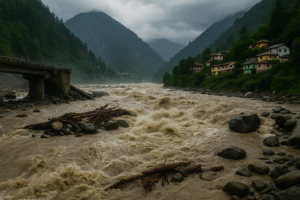Did you know that some of the most powerful space telescopes on Earth can’t function properly if there’s too much light around?
That’s right—astronomers need pitch-black skies to see the universe clearly. In fact, the clearer and darker the sky, the better our view of distant galaxies, stars, and even black holes. This is why dark skies matter—not just for stargazers but for the future of space science itself.
But right now, one of the darkest and most important skywatching spots on Earth—the Atacama Desert in Chile—is under threat. And if we don’t act, we might lose a window into the universe that can’t be replaced.
The Desert That Sees the Stars Best
Located in northern Chile, the Atacama Desert is the driest non-polar place on Earth. But more than that, it’s a paradise for astronomers. It has almost no cloud cover, extremely dry air, and very little artificial light, making it the perfect place to build observatories.
Some of the world’s most advanced telescopes are based here:
- The Very Large Telescope (VLT) at the Paranal Observatory
- The Extremely Large Telescope (ELT) is currently under construction
- The Cherenkov Telescope Array Observatory (CTAO), which will be the largest facility in the world for studying high-energy gamma rays.
These telescopes are helping scientists unravel the secrets of dark matter, black holes, and the origins of galaxies. But their success depends on one simple factor: darkness.
The Threat: A Green Energy Project Near the Stars
Here’s where the problem begins. A company called AES Andes, a Chilean subsidiary of AES Corporation (a U.S.-based energy company focused on clean energy projects), has proposed building a green hydrogen plant just 11 kilometres from the Paranal Observatory.
Green hydrogen is created by harnessing renewable sources such as solar and wind energy. It’s seen as a promising alternative to fossil fuels and a step toward cleaner industries. Sounds like a win-win, right?
Unfortunately, not in this case.
According to the European Southern Observatory (ESO)—the scientific organization that runs the VLT and is building the ELT—this project could increase light pollution by at least 35% at the VLT and 55% at the CTAO. It would also raise local air turbulence and vibrations, further degrading telescope performance.
The ESO’s experts say this could cause “devastating, irreversible” damage to astronomical research in the region.

Why Light Pollution Is Such a Big Deal
Think of a telescope like a giant, ultra-sensitive camera. Even a small amount of background light—like a city glow in the distance or a security light nearby—can mess up its images.
Astronomers compare light pollution to putting on sunglasses. The brighter the sky, the fainter the stars appear. In fact, adding artificial light is like making your telescope mirror smaller. You simply can’t see as deep or as far into space.
Worse still, light pollution doesn’t just blur the view. It can completely erase faint objects like distant galaxies, nebulae, or supernovae from our instruments.
That’s why observatories are built far from cities, usually on mountaintops in remote areas. And that’s exactly why scientists are raising the alarm about the hydrogen plant.
Clashing Numbers and Conflicting Views
AES Andes insists their project won’t hurt the observatories. They say they followed all environmental regulations and even invited ESO to provide feedback on their lighting design. According to them, the increase in sky brightness would be as little as 0.27% at Paranal, 0.45% at CTAO, and just 0.09% at the ELT.
These numbers are far lower than the ESO’s estimates.
So why the big difference?
The ESO’s analysis was conducted by respected experts, including Martin Aubé from the Centre for Research in Astrophysics of Quebec in Canada. Their findings are based on real satellite data and physical models of how light travels in the atmosphere.
AES Andes may have used less sensitive models or underestimated how their lighting spreads in open desert conditions.
Not the First Project—But the Closest One Yet
Astronomers aren’t against green energy. In fact, many in the scientific community support renewable energy solutions. The problem here is about location.
Over the years, several industrial projects have popped up in the wider Atacama region—but they’ve all stayed at least 50 kilometres away from major observatories. The AES hydrogen facility would be just a few kilometres away, making it the closest large-scale industrial site ever proposed in this sensitive zone.
Even Chile’s own Antofagasta Environmental Agency called for an early rejection of the project, saying it had too many problems to fix.
What We Stand to Lose
The Atacama’s skies are more than just beautiful—they’re a scientific treasure. The discoveries made there don’t just help Chile or astronomers; they help all of humanity.
We’re talking about exploring the early universe, studying exoplanets that might host life, and even detecting mysterious cosmic phenomena like gravitational waves or gamma-ray bursts. These are missions that can’t just move to another location.
As Xavier Barcons, Director-General of the ESO, puts it:
“What we could lose here cannot be replaced anywhere else in the world.”

Balancing Sustainability and Science
This story isn’t just about one project or one country. It’s a global reminder that even green projects can have hidden environmental costs—especially when placed near rare and valuable resources like dark-sky regions.
We need clean energy, yes. But we also need science to guide us into the future. It’s time to ask: Is it possible to build sustainably without sacrificing our irreplaceable windows into the universe?
Conclusion: Dark Skies Matter—Now More Than Ever
Protecting dark skies is not just about helping astronomers. It’s about keeping our connection to the cosmos alive. It’s about ensuring that the next generation can discover new planets, galaxies, and maybe even life beyond Earth.
If we let short-term development block our view of the universe, we’re closing a door we may never reopen.
So the next time you see a starry night—or better yet, visit a dark-sky location—remember how rare and precious that view really is.
Author’s Note
Thanks for reading! I’ve always been fascinated by astronomy, and writing this blog reminded me just how delicate our access to the universe really is. If this post made you think, please share it. Together, we can spread the word about why protecting dark skies truly matters.
G.C., Ecosociosphere contributor.
References and Further Reading
- Nature Article on the Atacama Telescope Conflict
- International Dark-Sky Association
- (2024). Exoplanet Adaptive Characterization with the ELT. MENA Report, (),.





Comments
Puraburn This is my first time pay a quick visit at here and i am really happy to read everthing at one place